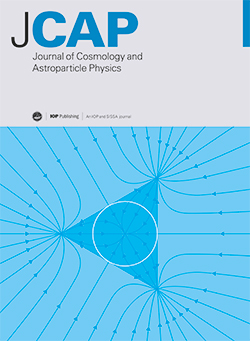选择具有较少上帝之指的星系样本
IF 5.9
2区 物理与天体物理
Q1 ASTRONOMY & ASTROPHYSICS
Journal of Cosmology and Astroparticle Physics
Pub Date : 2025-07-03
DOI:10.1088/1475-7516/2025/07/014
引用次数: 0
摘要
从测量的红移中推断出的星系的径向位置由于其特殊的速度而显得扭曲。我们认为,随机速度的贡献——在推断的地图中产生了“上帝之指”(FoG)的各向异性——并不适合目前实验所针对的尺度上的扰动建模。为了绕过这一限制,我们建议使用数据驱动的局部丰度指标来去除FoG,从而避免选择偏差。特别是,我们证明了测量的功率谱四极杆变化符号所在的尺度与卫星分数和速度色散都是紧密反相关的,因此可以用来选择具有较少FoG的星系样本。此外,我们还表明,排除质量大于给定质量阈值的晕中的星系可以帮助丢弃许多最有问题的星系。这种选择可以在实践中使用宇宙微波背景频谱的热Sunyaev-Zel'dovich失真图来实现。这些技术可能潜在地改善从星系红移空间位置重建大尺度速度和位移场。它们也可能扩展星系群集的摄动模型的范围,尽管在实践中,我们发现当将单回路EFTofLSS模型拟合到具有减轻FoG的模拟时,由于其他影响的相关性以双环顺序进入,因此只有边际收益。本文章由计算机程序翻译,如有差异,请以英文原文为准。
Selecting samples of galaxies with fewer Fingers-of-God
The radial positions of galaxies inferred from their measured redshift appear distorted due to their peculiar velocities. We argue that the contribution from stochastic velocities — which gives rise to `Fingers-of-God' (FoG) anisotropy in the inferred maps — does not lend itself to perturbative modelling already on scales targeted by current experiments. To get around this limitation, we propose to remove FoG using data-driven indicators of their abundance that are local in nature and thus avoid selection biases. In particular, we show that the scale where the measured power spectrum quadrupole changes sign is tightly anti-correlated with both the satellite fraction and the velocity dispersion, and can thus be used to select galaxy samples with fewer FoG. In addition, we show that excluding galaxies in haloes more massive than a given mass threshold can help to discard many of the most problematic galaxies. Such selection could be achieved in practice using maps of the thermal Sunyaev-Zel'dovich distortion of the cosmic microwave background frequency spectrum. These techniques could potentially improve reconstructions of the large-scale velocity and displacement fields from the redshift-space positions of galaxies. They may also extend the reach of perturbative models for galaxy clustering, though in practice we find only marginal gains when fitting one-loop EFTofLSS models to simulations with mitigated FoG due to the relevance of other effects entering at two-loop order.
求助全文
通过发布文献求助,成功后即可免费获取论文全文。
去求助
来源期刊

Journal of Cosmology and Astroparticle Physics
地学天文-天文与天体物理
CiteScore
10.20
自引率
23.40%
发文量
632
审稿时长
1 months
期刊介绍:
Journal of Cosmology and Astroparticle Physics (JCAP) encompasses theoretical, observational and experimental areas as well as computation and simulation. The journal covers the latest developments in the theory of all fundamental interactions and their cosmological implications (e.g. M-theory and cosmology, brane cosmology). JCAP''s coverage also includes topics such as formation, dynamics and clustering of galaxies, pre-galactic star formation, x-ray astronomy, radio astronomy, gravitational lensing, active galactic nuclei, intergalactic and interstellar matter.
 求助内容:
求助内容: 应助结果提醒方式:
应助结果提醒方式:


